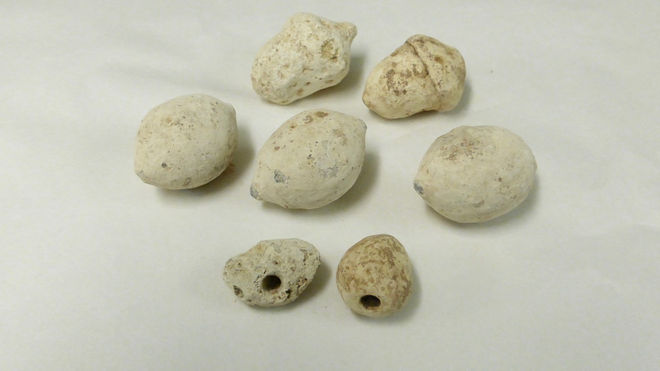“You don’t just have these silent but deadly bullets flying over; you’ve got a sound effect coming off them that would keep the defenders’ heads down, Every army likes an edge over its opponents, so this was an ingenious edge on the permutation of sling bullets.” – John Reid of Trimontium Trust

PHOTO: livescience
BURNSWARK HILL, SCOTLAND – Archaeologists have discovered what might be one of the earliest terror weapons in history: whistling sling bullets used by Roman centurions over 1,800 years ago.
Archaeologists have been finding slingshot bullets at Roman and Greek sites for years. Bullets with holes punched in them have been found at battle sites in Greece from the second and third centuries BC, but most archaeologists working on those sites assumed the holes were meant for poison. But, that theory doesn’t exactly hold water. The holes are too small, and there isn’t any guarantee that the stones would ever puncture the skin.
The researcher who first came up with the idea that the stones were designed to whistle was John Reid, an archaeologist working with Trimontium Trust, a Scottish historical society working on the archaeological investigation at Burnswark Hill. He got the idea from his brother, a fisherman.
“I said [to my brother]. ‘Don’t be stupid; you’ve no idea what you’re talking about. You’re not an archaeologist,’ And he said, ‘No, but I’m a fisherman, and when I cast my line with lead weights that have got holes in them like that, they whistle’…Suddenly, a light bulb came on in my head — that’s what they’re about. They’re for making a noise.” – John Reid
In the 1st and 2nd centuries AD, Rome was trying to make a conquest out of ancient Britain. They knocked down the southern half on the island, establishing their presence in the city of London, which still flourishes today as England’s capital. The tribes up north weren’t too happy about the Roman invasion, and to keep hold of the ground they had, Emperor Hadrian built the famous “Hadrian’s Wall”. From there, a conquest of northern Britain and modern-day Scotland was then launched.
The Scots-Gaelic tribes in the north were a fierce and independent people, though, and they had the terrain on their side. The farther north you go in Britain, the harder it is the navigate an army. The Gaelic tribes practiced guerrilla warfare. They knew the land better than the Romans, and servicing an army that far north was extremely difficult. Eventually, the Romans decided to pull their troops back behind the wall and retreat south.
When Rome was invading Britain, Roman legions would be joined by auxiliary troops armed with slingshots. They were experts at what they did, able to fire a heavy sling bullet or stone at speeds of 100 mph. The biggest stones could actually take a man’s head clean off of his shoulders.
It’s likely the Romans were trying to use these weapons to instill fear in the hearts of the “barbarian” defenders they were fighting northern Scotland. In that terrain, against those kind of fierce warriors, when all the odds were against them, the Roman soldiers could use any advantage they could get a hold of. Reid speculates that the assault at Burnswark Hill was a huge battle meant to demonstrate to the natives what, exactly, would happen to them and their families should they resist the might of the Roman Empire.
The archaeologists and researchers will continue to work on Burnswark Hill. For now, the dig is left in the hands of the Scottish historical society. Hopefully, more artifacts and insights as to Scotlands early history will be discovered in the future.

